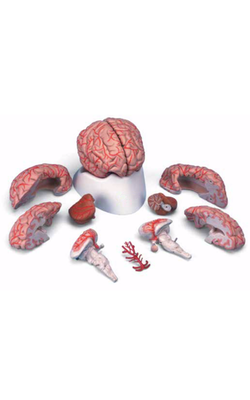Main Model

Cranial Nerves : IX Glossopharyngeal nerve

Glossopharyngeal Nerve (CN IX)
Functions: Sensory - somatic (general) sensory, special sensory (taste), and visceral sensory. Motor - somatic (branchial) motor, and visceral (parasympathetic) motor for derivatives of the 3rd pharyngeal arch.
Nuclei: Four nuclei in the medulla send or receive fibers via CN IX: two motor (nucleus ambiguus and inferior salivary nucleus) and two sensory (sensory nuclei of the trigeminal nerve [CN V] and nuclei of the solitary tract). Three of these nuclei (nucleus ambiguus, sensory nuclei of the trigeminal nerve and nuclei of the solitary tract) are shared with CN X.
The glossopharyngeal nerve (CN IX) emerges from the lateral aspect of the medulla and passes anterolaterally to leave the cranium through the anterior aspect of the jugular foramen. At this foramen are the sensory superior and inferior ganglia of CN IX, which contain the pseudounipolar cell bodies for the afferent components of the nerve. CN IX follows the stylopharyngeus, the only muscle the nerve supplies, and passes between the superior and middle pharyngeal constrictor muscles to reach the oropharynx and tongue. It contributes sensory fibers to the pharyngeal plexus of nerves. CN IX is afferent from the tongue and pharynx (hence its name) and efferent to the stylopharyngeus and parotid gland.
Somatic (Branchial) Motor
Motor fibers pass to one muscle, the stylopharyngeus, derived from the 3rd pharyngeal arch.
Visceral (Parasympathetic) Motor
Following a circuitous route initially involving the tympanic nerve, presynaptic parasympathetic fibers are provided to the otic ganglion for innervation of the parotid gland. The otic ganglion is associated with the mandibular nerve (CN V3), branches of which convey the postsynaptic parasympathetic fibers to the parotid gland.
Somatic (General) Sensory
The general sensory branches of CN IX are as follows:
• The tympanic nerve.
• The carotid sinus nerve to the carotid sinus, a baro- (presso-) receptor sensitive to changes in blood pressure, and the carotid body, a chemoreceptor sensitive to blood gas (oxygen and carbon dioxide levels).
• The pharyngeal, tonsillar, and lingual nerves to the mucosa of the oropharynx and isthmus of the fauces (Latin throat), including palatine tonsil, soft palate, and posterior third of the tongue. In addition to general sensation (touch, pain, temperature), tactile (actual or threatened) stimuli determined to be unusual or unpleasant here may evoke the gag reflex or even vomiting.
Special Sensory (Taste)
Taste fibers are conveyed from the posterior third of the tongue to the sensory inferior ganglia of CN IX.